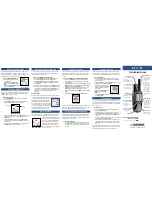
3.5.3
Non-Tactical Emergency
In Non-Tactical Emergency, the radio switches to a designated Emergency talkgroup when starting
Emergency Operations. This talkgroup is used for the complete duration of the Emergency Operation.
Changing talkgroups is not allowed at this point.
In Trunked Mode Operation (TMO), the radio can make Emergency Non-Tactical Group Calls without
sending attachments. If configured, the radio assumes implicit attachments after receiving a temporary
address.
In Direct Mode Operation (DMO), the Non-Tactical Emergency proceeds on the same frequency as the
previously selected talkgroup. The service provider can designate any Individual TETRA Subscriber
Identity (ITSI) address to be used for Emergency Operations. This ITSI can be an Open Group -
broadcast address.
After exiting from Non-Tactical Emergency, the radio returns to the previously selected talkgroup.
3.5.4
Emergency Individual Calls (Private or MSISDN)
The Emergency Individual Calls are simplex or duplex calls with emergency priority.
On pressing the
Emergency
button, the radio initiates an individual call to a provisioned private or
Mobile Station Integrated Services Digital Network (MSISDN) address.
This feature also supports the direct or hook dialing method on simplex and duplex calls. For full
duplex Emergency Individual Calls initiated to an MSISDN address, the default dialing method is
configured to hook. This default dialing method cannot be modified.
In Emergency Individual Calls, the radio rejects all incoming individual calls with nonemergency
priority. These rejected calls are shown as missed calls after the Emergency Individual Calls have
ended.
Emergency Full Duplex Private Calls (FDPC) supports high/low audio state. The audio state is
configurable. You can select the audio state during incoming or outgoing emergency FDPC by toggling
hi or low audio during active Emergency FDPC.
3.5.5
Emergency SDS Status
The radio sends a status message with a preprogrammed value to the destination address set by
your service provider. Emergency SDS Status is available in TMO only. If no status acknowledgment
or negative acknowledgment is received, the radio retries sending the message. Status is not resent
when Emergency Alarm or Hot Microphone is configured.
3.5.6
Emergency Hot Microphone
The Hot Microphone allows you to talk without pressing the
PTT
button during Emergency Operation.
The transmission continues for a provisioned amount of time. If configured, pressing the
PTT
button
before the Hot Microphone time expires ends the Hot Microphone operation. Then normal PTT
operation in Emergency group call takes over whereby the transmission is ongoing for the time the
PTT
button is held.
Subsequent
Emergency
button presses during the Emergency Operation restart the Hot Microphone
transmission.
If a talk permit is granted to another member of the group, the Emergency Call received tone is played.
If configured, the radio automatically attempts to get talk permit again.
MN005826A01-AE
Chapter 3 : Modes
62
















































